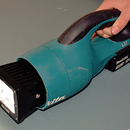Introduction: Solar Powered Ceiling Fan (Chirstmas Gift)
I made this project for a friend who is a bit down on his luck and living in a small community with no power, water, toilet or pretty much anything else you would expect in a western country. There are a number of permanent residents living in illegal shacks, caravans, buses, shipping containers or camper-vans and a number of others who stay for a few weeks or months of the year but usually leave before the hot weather as it can get to 45 degrees C (113 F) for days at a time. The area is known locally as foot rot flats and is not unlike a small version of slab city in the US.
Back to my friend in his corrugated iron dirt floor shack, it gets really hot in there, so I thought I would make up a ceiling fan that would run off a solar panel.
Step 1: Stuff You Will Need
The heart of this project is a treadmill motor. They are a permanent magnet dc motor and are rated at 180 volts and 4700rpm. We will only be running it at about 15 volts and they run nicely off a 12 volt solar panel at about 400 rpm. I picked up a treadmill at the local tip and also found an old ceiling fan, so the motor and blades were removed.
If you cant find a motor they sometimes come up on ebay priced from $5 - $70
Shopping list
- Treadmill motor
- Ceiling fan blades
- 12 volt solar panel 40 watts like this one
- Wiring
- switch
- tube to make a motor mount
- Nuts bolts and screws
- paint
Tools
- 5mm drill
- 6mm tap
- centre punch
- hole saw
- volt and amp meter
- CAD program or ruler, paper and compass
- general workshop equipment
Step 2: Remove the Flywheel
This bit is easy just remove the grub screw inside of the flywheel and the screw in the end of the motor, and the fly wheel will just slide off. save all the screws for later
Step 3: Make a Paper Template
The mounting point for the blades must be really accurate, or the fan will be out of balance and wobble. This would not only make an annoying noise it would also waste power as energy is put into shaking the fan to death rather than spinning the blades. I make my template using a CAD program but if you are handy with a compass and a ruler you could also make one with out a computer.
You might want to think about how many blades you would like on your fan at this stage, the more blades on your fan the more load will be on the motor and more watts you will need to drive it.
I found three blades with a 40 watt 12volt panel was about the same as a domestic AC ceiling fan going flat out. Using a 100 watt 24 volt panel was like a industrial fan and is probably a bit silly inside, as stuff started flying around and it started getting a bit noisy.
- For three blades draw 2 circles one a 30mm the other 110mm
- If using CAD draw one line from the centre and duplicate 3 times around the centre. you can then chose the correct size paper and print in true scale.
- If using a compass, after drawing the 110 mm circle don't adjust the compass, you can then mark out six points around the circumference of the circle and chose ever 2nd one for the mounting point of the blades.
- Check out the photos if your not clear on how to do it. (The template was drawn with a a marker pen for photos clarity, in practice you would use a very sharp pencil for accuracy.)
- You can then carefully fold the paper in half and cut out the centre
- Check the blades for fit and most flywheels will have balancing holes you will have to avoid
Step 4: Drill and Tap the Flywheel
Once the template is in the correct position three of the mounting points can be centre punched and drill with a 5mm drill. I found the fan on the back of the flywheel was interfering with the drill so it was removed. The flywheel is cast iron and quite soft, so drilling and taping with a 6mm tap was quite easy.
Once the first 3 holes are drill the fan blades can be fitted and the next 3 holes centre punched as shown in the photos.
The blades can then be removed and last 3 holes can be drilled and taped.
Step 5: Reverse the Pitch on the Blades
Now you don't have to do this step if you don't want to but I tell you why its a good idea. The treadmill motor normally runs counter clockwise which is the opposite direction to a normal ceiling fan. Now you can just change the + and - leads around and make the motor run backwards and your fan will work correctly, but on the all the motors I've found, the brushes make a clicking noise when the motor is reversed. The motors are clearly not designed to run backwards and I think it will probably wear the brushes out quickly if run in reverse.
Back to the blades, Just grip each blade in the vise and twist them the other way around try and get them all the same
Step 6: Marking Out the Motor Mount
The motor mount is just a piece of rectangular tube with some holes drill in it Some of my students struggle with drilling two holes to line up with two bolt holes, this is how I do it.
- Paint the steel with a black marker, and use some digital callipers to scribe a line down the centre of the steel.
- Use your callipers to measure from one side of the hole to the same side of the other hole (see the photo)
- You can then mark out the centre of the two holes,centre punch and drill them.
- A hole saw is used on the back, so the bolt can be dropped it and the end cut on an angle to make access easy for the second bolt
Step 7: Wiring Up and Testing
The motor leads can then be extended by soldering and length of wire to it and using heat shrink to insulate everything. A hole saw was used again and the wire threaded up the centre of the tube to keep everything tidy.
With a 12 volt 40 watt panel in full sun it was drawing 1.65 amps at 17.46volts (28.8 watts).
After increasing the pitch on the blades I was able to get a little more air flow and at 1.87 amps and 16.0volts it was pulling around 30 watts. I think its about as much performance as I'm going to get considering, solar panels are rated at 25 degrees C and are a bit optimistic, there performance also drops off with heat, cloud, dirt and the time of day.
After comparing the fans in my house I got a similar amount of air flow as if they were turned on high. And with a 24 volt panel its awesome, papers and crap are gone!
Step 8: Paint
Paint will make any project look better. So after sanding off any shape edges and lose paint, the fan was wiped down with acetone and the back of the motor taped up to prevent paint entering and gumming up the works. I had some cream coloured paint in a spray can, and I gave it three coats.
Step 9: Installation
Installing the fan is easy just screw it to the ceiling and run the wire outside to your solar panel. A couple of the local residents gave me a hand, and they were so appreciative, they couldn't believe that I had made it for them. For many of them Christmas is not a happy time of the year, all have financial problems some are estranged from their family, or have drug or alcohol problems. It didn't take long for a number of locals to come out and sit under the fan even a passing dog came in and lay down under it.
When wiring it up you have a number of options to power the fan.
- Power directly from a solar panel
- Power from a battery and use the solar panel to charge the battery.
- Use excess power from a existing solar charging system. (see the diagram)
After discussions with the residents we chose the 3rd option as they had a large array of panels but the battery bank is in need of replacement as it runs flat quite quickly.
This would mean the fan will only run when the sun is on the panels, the battery would not see any extra load, and they would not have to tie up another panel just for the fan.
The fan was wired between the solar panel and the regulator, and after a few test it was found that in full sun the the fan was running on 19 volts and the battery will still getting still getting up to 15 amps (12volt system).
This works well as the regulator turns the load from the panel off and on the fan speeds up using any extra power from the panels.

Second Prize in the
MAKE ENERGY: A US-Mexico Innovation Challenge

Participated in the
Homemade Gifts Contest













